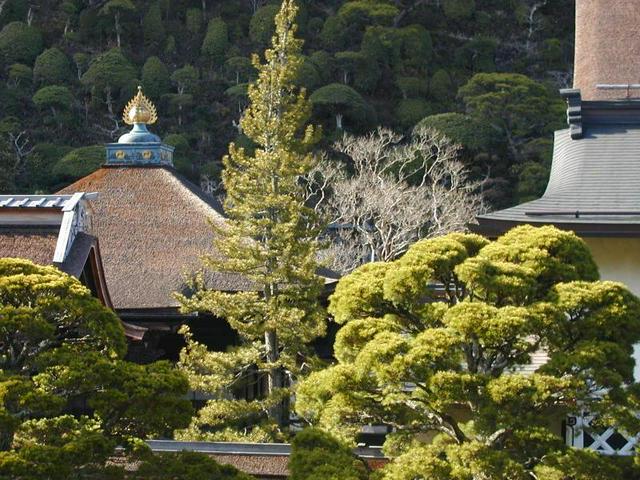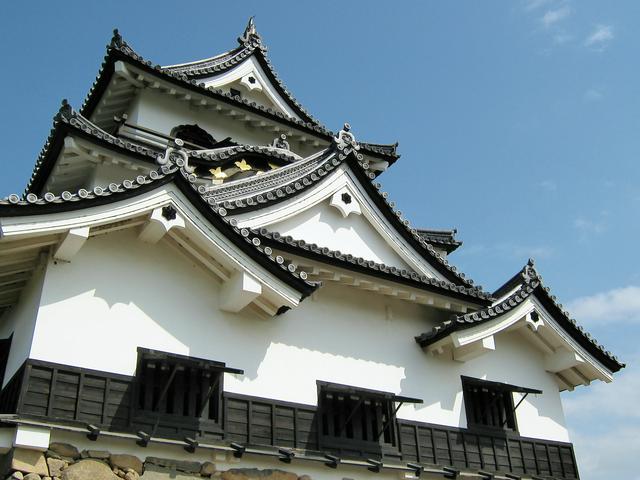Kansai (関西) is the western region of the main Japanese island of Honshu, second only to Kanto region of Eastern Japan in population. The area is also known as Kinki (近畿) District, literally "near the capital" (referring to ancient capital Nara and Kyoto), and its three big cities — Osaka, Kyoto, and Kobe — as Keihanshin (京阪神).
- Hikone. - castle and garden town off the beaten track
- Himeji. - small city famed for its beautiful castle
- Ise. - home to the eponymous Ise Shrine, the holiest in all Japan
- Kobe. - maritime city known for its beef and Japan's oldest Chinatown
- Kyoto. - Japan's ancient capital, with temples and geisha
- Nara. - an even more ancient capital (than Kyoto) centered around a beautiful park
- Osaka. - mega-world city famed for its food and nightlife is the principal city of Kansai region
- Otsu. - home to Mount Hiei and the temple where Tale of Genji was written
- Takarazuka. - Famous for its all women theater -For manga fans, the Tezuka Osamu Manga Museum
Hikone. - castle and garden town off the beaten track
Himeji. - small city famed for its beautiful castle
Ise. - home to the eponymous Ise Shrine, the holiest in all Japan
Kobe. - maritime city known for its beef and Japan's oldest Chinatown
Kyoto. - Japan's ancient capital, with temples and geisha
Nara. - an even more ancient capital (than Kyoto) centered around a beautiful park
Osaka. - mega-world city famed for its food and nightlife is the principal city of Kansai region
Otsu. - home to [[Mount Hiei]] and the temple where Tale of Genji was written
Takarazuka. - Famous for its all women theater -For manga fans, the Tezuka Osamu Manga Museum
- Arima Onsen. - one of Japan's Three Old Hot Springs just across the hill from Kobe
- Kinosaki. - another famous historic spring town near the Sea of Japan
- Awaji Island. - gateway to Shikoku
- Horyuji. - temple complex housing some of the oldest wooden buildings in the world
- Lake Biwa. - the largest lake in Japan and nice for a quick break
- Mount Hiei. - headquarters of Tendai and protector of Kyoto
- Mount Koya. - mountaintop headquarters of the Buddhist Shingon sect
- Iga. and Koka. - hometowns of ninja
Arima Onsen. - one of Japan's Three Old Hot Springs just across the hill from Kobe
Kinosaki. - another famous historic spring town near the Sea of Japan
Awaji Island. - gateway to [[Shikoku]]
Horyuji. - temple complex housing some of the oldest wooden buildings in the world
Lake Biwa. - the largest lake in Japan and nice for a quick break
Mount Hiei. - headquarters of Tendai and protector of Kyoto
Mount Koya. - mountaintop headquarters of the Buddhist Shingon sect
Iga. and Koka. - hometowns of ninja
Iga. and Koka. - hometowns of ninja
Kansai is the cradle of the Japanese civilization, with former capital cities Asuka, Nara, and Kyoto.
Differences between Kansai and Kanto (the eastern region dominated by Tokyo) are slight but numerous. Kansai people speak a distinctive dialect of Japanese, use lighter-colored soy in their cooking, ride on the other side of escalators and are renowned for humor and their love of food.
While 22 million people live in Kansai, the region also has spectacular natural sceneries, and four of the country's national parks.
The Kansai dialect (関西弁 Kansai-ben) is Japan's largest dialect group after Tokyo's dialect group collectively. There are many subdialects, ranging from the elegant and euphemistic Kyo-kotoba (京言葉) of Kyoto's courtiers to the gruff but imaginative gangster slang of Osaka, much favored by Japanese comedians. Some notable features include the copula ya instead of da, the negative ending -hen instead of -nai, the use of akan (あかん, アカン) instead of dame for "No way!", aho (あほ, アホ) instead of baka for "idiot", and ōki-ni (おおきに) instead of arigatō gozaimasu for "Thanks".
That said, most Kansaites are perfectly conversant in standard Japanese, so knowledge of the local dialect is by no means necessary, but even a few words will be appreciated. The typical Osakan greeting is Mōkarimakka? ("Making money?"), to which the typical reply is Bochi-bochi denna ("Well, so-so"); trying this out on a friend or acquaintance is guaranteed to produce a surprised smile, and make you look like a omoroi (funny) guy.
English is taught at all schools in Japan, and while it is less commonly spoken than in Tokyo you will find that younger people will often know enough English to communicate, especially those residing in the cities. Still, learning even a few important phrases in Japanese will be appreciated and not as difficult as many Westerners think.

With its political and geographical significance in the history of Japan, the region of Kansai possesses three quarters of Japan's "National Treasure" buildings, half of its "National Treasure" artworks, as well as five UNESCO World Heritage Sites, making it an unmatched destination for heritage tourists to Japan.
- Horyuji Temple and Hokkiji Temple in Horyuji became the nation's very first World Heritage Sites in 1993.
- Himeji Castle, (Himeji) the largest original castle in Japan.
- Eight Sites in Nara make up the Historic Monuments of Ancient Nara, including Todai-ji which houses one of the world's most famous Buddha statues, the beautiful Kasuga Shrine and the Kasuga Primeval Forest on the mountain behind it, Heijo-kyo the former palace site, and four other temples.
- The Historic Monuments of Ancient Kyoto are a list of 14 sites in Kyoto#World Heritage Sites, 2 in Uji (Byodoin and Ujigami Shrine), and 1 in Otsu (Enryaku-ji on Mount Hiei).
- The shrines and temples of Yoshino, Mount Koya and Kumano are all part of the single site known as the Sacred Sites and Pilgrimage Routes in the Kii Mountain Range.
- The Mozu-Furuichi Kofungun Ancient Tumulus Structures are a collection of burial mounds in Sakai and Fujiidera. The Nintoku Tombs are the largest and most important of the listings.
Horyuji Temple and Hokkiji Temple in [[Horyuji]] became the nation's very first World Heritage Sites in 1993.
Himeji Castle, ([[Himeji]]) the largest original castle in Japan.
Eight Sites in [[Nara]] make up the Historic Monuments of Ancient Nara, including Todai-ji which houses one of the world's most famous Buddha statues, the beautiful Kasuga Shrine and the Kasuga Primeval Forest on the mountain behind it, Heijo-kyo the former palace site, and four other temples.
The Historic Monuments of Ancient Kyoto are a list of 14 sites in [[Kyoto#World Heritage Sites]], 2 in [[Uji]] (Byodoin and Ujigami Shrine), and 1 in [[Otsu]] (Enryaku-ji on Mount Hiei).
The shrines and temples of [[Yoshino]], [[Mount Koya]] and [[Kumano]] are all part of the single site known as the Sacred Sites and Pilgrimage Routes in the Kii Mountain Range.
The Mozu-Furuichi Kofungun Ancient Tumulus Structures are a collection of burial mounds in [[Sakai]] and [[Fujiidera]]. The Nintoku Tombs are the largest and most important of the listings.

Kansai is home to two of the nation's remaining original castles. Both are designated National Treasures.
- Himeji Castle (Himeji) World Heritage Site reopened in 2015 after years of rennovation, the "White Heron Castle" is now whiter than ever.
- Hikone Castle (Hikone) An impressive castle that also retains its original accompanying garden and an informative museum.
Himeji Castle ([[Himeji]]) World Heritage Site reopened in 2015 after years of rennovation, the "White Heron Castle" is now whiter than ever.
Hikone Castle ([[Hikone]]) An impressive castle that also retains its original accompanying garden and an informative museum.
- Osaka Castle, Osaka
- Ako Castle, Ako
- Nijo Castle, Kyoto
- Fushimi Castle, Kyoto
- Fukuchiyama Castle, Fukuchiyama
- Kishiwada Castle, Kishiwada
- Wakayama Castle, Wakayama
- Iga Ueno Castle, Iga
- Nagahama Castle, Nagahama
- Takeda Castle, Asago
- Azuchi Castle, Omihachiman
- Matsusaka Castle, Matsusaka
- Genkyuen Garden - Garden of the lords of Hikone Castle (Hikone)
- Shoseien Garden - A quiet garden villa in central Kyoto owned by Honganji Temple (Kyoto)
- Kokoen Garden A modern garden with a pond, herb garden, and bamboo grove (Himeji)
- Isuien Garden Beautiful garden that utilizes Todaiji Temple and Mount Wakakusa as borrowed scenery (Nara)
Genkyuen Garden - Garden of the lords of Hikone Castle ([[Hikone]])
Shoseien Garden - A quiet garden villa in central Kyoto owned by Honganji Temple ([[Kyoto]])
Kokoen Garden A modern garden with a pond, herb garden, and bamboo grove ([[Himeji]])
Isuien Garden Beautiful garden that utilizes Todaiji Temple and Mount Wakakusa as borrowed scenery ([[Nara]])
Kansai cooking is subtly different from the Kanto style, although the average short-term visitor is unlikely to spot many differences. Perhaps the most visible differences are a tendency to use light-colored soy instead of dark, especially in soups, and a preference for thick white udon noodles over the thin buckwheat soba noodles of eastern Japan.
Some famous Kansai dishes include:
- sabazushi (鯖寿司 mackerel sushi), Battera of Osaka, sabazushi in Kyoto, or kaki-no-ha zushi (柿の葉寿司) from Nara are local variants of this type
- okonomiyaki (お好み焼き), variously described as Japanese pizza or pancakes. Although Hiroshima also makes a strong claim for this name, they are in fact reasonably different from each other. (Hiroshima style tends to come cooked on a pile of noodles.)
- takoyaki (たこ焼き) is the common name for the fried balls of octopus and batter. Akashiyaki (明石焼き) from Akashi City area is recognized as the origin of the more famous Osaka-style takoyaki. As opposed to the Osaka-style being served with dark and thick sauce on it, Akashiyaki are eaten without sauce but dipped into clear soup. When visiting takoyaki bars, the various fillings mentioned are generally substituted for octopus, rather than being an addition.
- beef (和牛), there are famous beef brands; Kobe beef (神戸牛), Matsusaka beef (松阪牛), Tajima beef (但馬牛) and Omi beef (近江牛).
- udon (うどん) is the popular noodle in Osaka instead of soba in Tokyo. Another udon area, Sanuki in Shikoku, is famous for chewy noodle, while Osaka is famous for soft noodle.
sabazushi (鯖寿司 mackerel sushi), Battera of Osaka, sabazushi in Kyoto, or kaki-no-ha zushi (柿の葉寿司) from Nara are local variants of this type
okonomiyaki (お好み焼き), variously described as Japanese pizza or pancakes. Although [[Hiroshima]] also makes a strong claim for this name, they are in fact reasonably different from each other. (Hiroshima style tends to come cooked on a pile of noodles.)
takoyaki (たこ焼き) is the common name for the fried balls of octopus and batter. Akashiyaki (明石焼き) from Akashi City area is recognized as the origin of the more famous Osaka-style takoyaki. As opposed to the Osaka-style being served with dark and thick sauce on it, Akashiyaki are eaten without sauce but dipped into clear soup. When visiting takoyaki bars, the various fillings mentioned are generally substituted for octopus, rather than being an addition.
beef (和牛), there are famous beef brands; Kobe beef (神戸牛), Matsusaka beef (松阪牛), Tajima beef (但馬牛) and Omi beef (近江牛).
udon (うどん) is the popular noodle in Osaka instead of soba in [[Tokyo]]. Another udon area, Sanuki in [[Shikoku]], is famous for chewy noodle, while Osaka is famous for soft noodle.
Kansai is sake country, with Nada (in Kobe) and Fushimi (in Kyoto) alone accounting for 45% of the country's production. Kobe in particular is a good place to tour sake breweries, many of which are open to visitors. Yamazaki, a halfway point between Osaka and Kyoto, is known for Japan's oldest commercial whisky distillery owned by Suntory.
